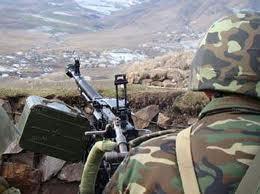
Armenian armed forces have broken the ceasefire with Azerbaijan 99 times in various parts of the contact line between Azerbaijani and Armenian armies in the last 24 hours using mortars and machine guns, Azerbaijani defense ministry told Trend Dec. 7.
Azerbaijani positions located in the villages of Gushchu Ayrim and Kemerli of the Gazakh district, Aghdam and Kokhanabi villages of the Tovuz district took fire from the positions located in the villages of Mosesgeh and Chinari of Armenia’s Berd district, Voskevan and Dovekh of the Noyemberyan district.
Meanwhile, Armenian armed forces located on the nameless heights of Armenia’s Krasnoselskiy district, opened fire at the positions of Azerbaijani armed forces located on the nameless heights of Gadabay district.
Azerbaijani positions also underwent fire from the positions located near the village of Talish of the Goranboy district, Chileburt, Gekarkh, Yarimja, Giziloba of the Terter district, Shikhlar, Javahirli, Kengerli, Sarijali, Novruzlu, Shuraabad, Yusifjanli of the Aghdam district, Kuropatkino of the Khojavend district, Horadiz, Garakhanbeyli, Ashagi Abdurrahmanli of the Fizuli district and Mehdili of the Jabrayil district.
Another ceasefire violation came from the positions located on the nameless heights of the Goranboy, Khojavend, Fizuli and Jabrayil districts.
Azerbaijani armed forces carried out 100 strikes on enemy positions.
The conflict between the two South Caucasus countries began in 1988 when Armenia made territorial claims against Azerbaijan. As a result of the ensuing war, in 1992 Armenian armed forces occupied 20 percent of Azerbaijan, including the Nagorno-Karabakh region and seven surrounding districts.
The two countries signed a ceasefire agreement in 1994. The co-chairs of the OSCE Minsk Group, Russia, France and the US are currently holding peace negotiations.
Armenia has not yet implemented the UN Security Council’s four resolutions on the liberation of the Nagorno-Karabakh and the surrounding regions.
Trend
